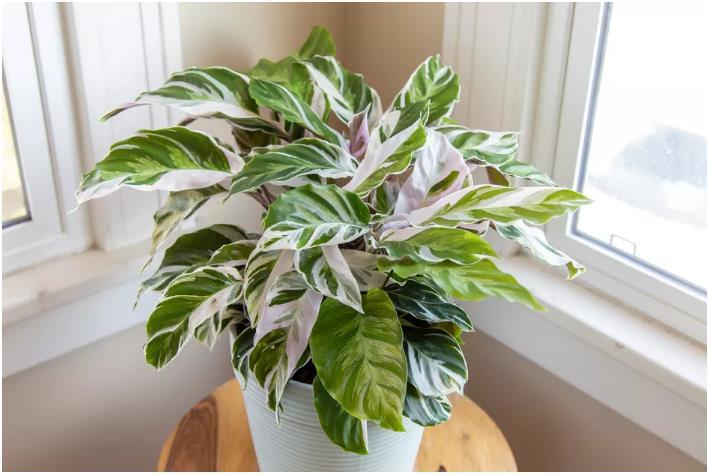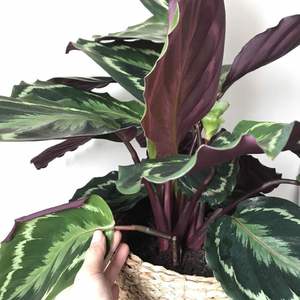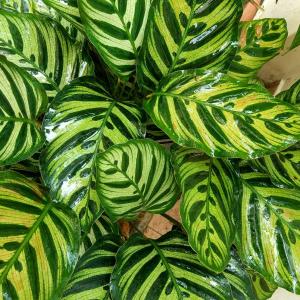文章
Miss Chen
2022年01月03日

Calathea are a tropical species that are popular houseplant additions because of the bold markings on their abundant foliage. They are also called peacock, zebra, or rattlesnake plants, referring to their decorative leaves resembling characteristics from those animals. In their native habitat, calathea species are known for their striking inflorescences. But they rarely flower indoors when grown as houseplants. It's best to divide and transplant this species in spring or summer.
The variegated foliage of the calathea 'White Fusion' cultivar features a leaf top side with contrasting white markings alongside the green. The underside has a pretty light purple-pinkish hue that runs down the stems. Although their care can be a little more particular than some houseplants, once you get it right, you will be rewarded with an eye-catching display of foliage that grows profusely and quickly.
Common Name Calathea 'White Fusion'
Botanical Name Calathea lietzei
Family Marantaceae
Plant Type Herbaceous Perennial
Mature Size Up to 2 ft. tall
Sun Exposure Partial
Soil Type Moist, Well-drained
Soil pH Acidic
Bloom Time Summer
Flower Color Yellow, purple, white
Hardiness Zones 11-12, USA
Native Area South America
Calathea Care
Calathea can be rather specific regarding their care requirements, and calathea 'White Fusion' is no exception. These plants like moisture, but not excessive amounts, sun is good, but not too much, and extreme temperatures need to be avoided.

You should regularly wipe down the calathea 'White Fusion' large leaves to remove dust. Removing dust from leaves allows the plant to breathe well. Don't use any leaf shine products; they can cause damage. Don't panic if you see an infrequent, small amount of discoloration or brown tips is to be expected; the foliage on this cultivar is delicate.
Light
Finding the right light level for your plant is one of the most critical care elements for your calathea 'White Fusion.' The wrong light level may cause poor development of the variegation on the plant. This plant needs filtered bright light. Too much light can cause the markings to fade and leaf curling; too shady a position and the markings won't develop properly in the first place.
Soil
Mixes recommended for African violets are often well-suited to calathea cultivars like 'White Fusion' as they retain moisture well and drain excess water. You can make a peaty, airy, lightweight potting mix by combining orchard bark, perlite, and standard potting soil.
Water
The calathea 'White Fusion' prefers to be consistently moist, but soggy and waterlogged conditions are a recipe for disaster. These plants like high humidity, but overly wet soils can lead to root rot and bacterial and fungal issues. Ensure the plant's pot has suitable drainage holes. Water thoroughly, but make sure the water drains out the bottom and does not pool in a collection plate.
Once the top inch of soil is dry, this is usually a good indicator that your plant needs more water. In the summer, you'll likely water once a week. Since the plant slows down its growth in the winter, it will require less water, probably only needing water every two weeks. Use the finger test to check the first inch of soil for moisture, but crisping leaves indicate that your plant is overly dry.
Many enthusiasts chose to use collected rainwater or distilled water for their calathea since this plant can be sensitive to chemicals in the water. Still, room temperature tap water is fine.
Temperature and Humidity
Avoid temperature extremes. Tropical species like calathea like humidity in their environment. Although they like warmer temperatures, sweltering heat can be too much for this plant. For example, if you heat your home all day in the winter but stop heating it at night, this sudden change can shock your plant. Also, the drying conditions from heating units can be a problem in decimating humidity levels.
If retaining humidity around the plant is a concern, you can sit the plant pot on top of a tray with some pebbles. Any water that drains out and collects in the pebbles will eventually evaporate and increase humidity levels without soaking the plant's roots. Or, you could invest in a humidifier, mainly if you are a collector of various tropical houseplants. Also, keep your calathea 'White Fusion' out of direct drafts but strike a balance by providing decent ventilation.
Fertilizer
Your calathea 'White Fusion' will appreciate a monthly application of liquid fertilizer during its growth period—spring through fall; stop feeding in the winter. Pick fertilizer designed for houseplants with dense foliage, likely a type that is more nitrogen-rich. The plant will only need a weak dose or half the strength recommended on the fertilizer container.
Pruning
If your calathea 'White Fusion' has a few leaves that have browned or curled excessively, don't be afraid to cut these off at the stem. Prune any dead, dying, or damaged leaves as soon as you spot them and remove them from the soil. If your plant is healthy and given the care and conditions it needs, new leaves grow and fill in for the dead ones. Deadhead faded blooms.
Propagating Calathea 'White Fusion'
The best time of year to propagate this plant is during the spring or summer during its period of vigorous growth. It can be propagated by division, leaf node cutting, or sown seeds. Use root division only if the mother plant is healthy. Dividing your plant helps you maintain your plant's size and keep the plant thriving. Once you divide, it will immediately make the plant look less full, but you will have two full-looking plants in time. Here's how to divide your calathea:
You'll need a 3-inch pot, well-draining potting soil, a sterilized knife or trowel, and a clean, flat workspace.
Several days before you divide your plant, water it thoroughly.
Inspect the plant for offsets or new shoots. These are baby plants developed by the mother plant. You can isolate that one shoot, its roots, and replant it. Or, you can take the current mother plant and split it in half. Or, you can do both. The offset should be at least 7 inches tall.
To take the plant out of the pot, turn the pot upside down, keep your hand fanned out wide at the base, securing the plant and its root ball in your hand.
If you have offsets or pups on your workspace, pull out those separate roots first. If you want to divide your plant in half, take your clean knife or trowel and make a sharp, clean cut through the root system. Ensure that each half has part of the root system and each leaf is attached to a stem.
Replant the pup in a smaller container than the mother plant; use a 4- to 6-inch container to start.
Place the plant in a bright spot but not directly in the sun.
To propagate via leaf note cutting:
You'll need a 3-inch pot, well-draining potting soil, sterilized scissors or pruning snips, and a clean, flat workspace.
Find a leaf node—the place where new leaves shoot from the stem—and cut about an inch below it. Make sure you have a few leaves intact with that node.
Plant the cutting in well-draining potting soil. Keep the soil moist but not soggy. Place the pot in a bright spot but not in direct sun.
In two weeks, roots will develop. Pull out the plant and its trailing roots and replant in a larger pot, about 2-inches larger.
How to Grow Calathea 'White Fusion' From Seed
To grow calathea from seed, use a moistened seed starting mix or well-draining potting soil. Plant the seed about 1/4-inch deep. Cover the container with plastic wrap to keep in the soil's humidity and maintain warm soil. If the soil needs warming, use a heating pad to help spur germination.
Put the pot in a bright but indirectly lit location. It can take up to a month for the seeds to sprout. Once a seedling grows at least an inch tall, carefully lift the sprout, keeping its root structure intact. Replant into a larger container, at least 2-inches larger.
Potting and Repotting Calathea 'White Fusion'
Repot it once a year (or every two years) to replenish the soil. Calathea plants that get rootbound invite fungal infections that will kill the plant. Increase the size of the container an inch or two each time. If you tend to overwater your plants, get an unglazed terra cotta pot since it’s porous and allows water to evaporate through the walls. If you tend to forget to water your plants, you might want to get glazed clay, plastic, or fiberglass pots. Repot your plant in spring or early summer during its active growing season. Water it thoroughly the day or two before repotting; it lessens the stress on the plant.
Overwintering
All calathea plants are tropical and will not survive a frost or freezing winter. As the temperatures begin to cool, prepare to bring your plant indoors to a bright spot with indirect sun by getting the plant used to indoor life slowly—only two hours a day at first, then increase by an hour each day. Keep the plant away from drafts and heaters. Keep the humidity high around the plant and mist the plant, if necessary. Once the outdoor climate warms again, gradually reintroduce the plant to outdoor life by bringing the plant out for two hours a day, then increasing by an hour each day. Temperature shifts are shocking for this plant and may cause a few leaves to drop.
Common Pests & Plant Diseases
Because they prefer a high humidity environment, fungus gnats can occasionally be a problem for calathea 'White Fusion.' They won't do any significant damage, but they are unsightly and not particularly pleasant. Apply neem oil to the leaves as a natural deterrent. Other common pests include aphids, mealybugs, spider mites, and scale. You can treat each with horticultural oil or insecticidal soap.
Calathea plants tend to get overwatered because they require high humidity, making them prone to bacterial or fungal infections. If your plant develops Pseudomonas leaf spot, looking like white splotches on the leaves, you will have to destroy the plant since there is no treatment for this bacterial infection; and it can spread to other plants. To reduce the risk of getting this disease again, do not water from overhead—water the soil only (not the leaves) or water from underneath.
Root rot is a fungal disease that causes rapidly yellowing leaves, stunted growth, and the base of the plant turns brown and rots. Take the plant out of the pot and inspect the roots below the soil line to treat root rot. Yellow roots are fine, but if browning, you must treat rotting roots immediately. Using sterile pruning snips or a knife, cut away any brown or mushy roots and discard them. Wash the pot in warm soapy water. Replace the soil with fresh, well-draining soil. Treat the place where the root was cut with an antifungal and plant it in the fresh soil. Keep the soil loose in the container so the roots can breathe.
How to Get Calathea 'White Fusion' to Bloom
Calathea 'White Fusion' produces small flowers when it reaches maturity, usually in the spring or summer. But when calathea are grown indoors, they very rarely bloom. If you replicate and maintain their ideal conditions indoors, then you might be rewarded with a bloom to let you know that you have figured out the secret to their growing success. However, the flowers are not much to look at and have no fragrance.

Common Problems With Calathea 'White Fusion'
Calathea plants of all types require a moderate amount of care. They are sensitive about their humidity, temperature, drafts, water level, and lighting. When any of these variables are out of balance, the plant becomes prone to growth issues or health problems.
Leaves Turning Brown
Leaves turn yellow, brown, or die when calathea white fusion is overwatered. Dead calathea white fusion leaves should be removed immediately so that the plant doesn't start to rot, smell bad, and invite fungus. The leaves of calathea 'White Fusion' may turn brown and droop or fall off if they are placed too close to a window or in direct sunlight. Move the plant further away from the window to protect the plant's delicate leaves.
Leaves Wilting or Drooping
When calatheas need more water, the leaves will wilt, curl, or droop downward from the main stalk. Increase water frequency or volume. You can also mist the plant's leaves or invest in a small humidifier to give the plant more moisture.
Leaf Patterns Disappearing
When this plant gets overexposed to the sun, it will produce more chlorophyll, making the green coloration in the leaf more dominant. Find a shadier spot with filtered or dappled light to fix this situation.
The variegated foliage of the calathea 'White Fusion' cultivar features a leaf top side with contrasting white markings alongside the green. The underside has a pretty light purple-pinkish hue that runs down the stems. Although their care can be a little more particular than some houseplants, once you get it right, you will be rewarded with an eye-catching display of foliage that grows profusely and quickly.
Common Name Calathea 'White Fusion'
Botanical Name Calathea lietzei
Family Marantaceae
Plant Type Herbaceous Perennial
Mature Size Up to 2 ft. tall
Sun Exposure Partial
Soil Type Moist, Well-drained
Soil pH Acidic
Bloom Time Summer
Flower Color Yellow, purple, white
Hardiness Zones 11-12, USA
Native Area South America
Calathea Care
Calathea can be rather specific regarding their care requirements, and calathea 'White Fusion' is no exception. These plants like moisture, but not excessive amounts, sun is good, but not too much, and extreme temperatures need to be avoided.

You should regularly wipe down the calathea 'White Fusion' large leaves to remove dust. Removing dust from leaves allows the plant to breathe well. Don't use any leaf shine products; they can cause damage. Don't panic if you see an infrequent, small amount of discoloration or brown tips is to be expected; the foliage on this cultivar is delicate.
Light
Finding the right light level for your plant is one of the most critical care elements for your calathea 'White Fusion.' The wrong light level may cause poor development of the variegation on the plant. This plant needs filtered bright light. Too much light can cause the markings to fade and leaf curling; too shady a position and the markings won't develop properly in the first place.
Soil
Mixes recommended for African violets are often well-suited to calathea cultivars like 'White Fusion' as they retain moisture well and drain excess water. You can make a peaty, airy, lightweight potting mix by combining orchard bark, perlite, and standard potting soil.
Water
The calathea 'White Fusion' prefers to be consistently moist, but soggy and waterlogged conditions are a recipe for disaster. These plants like high humidity, but overly wet soils can lead to root rot and bacterial and fungal issues. Ensure the plant's pot has suitable drainage holes. Water thoroughly, but make sure the water drains out the bottom and does not pool in a collection plate.
Once the top inch of soil is dry, this is usually a good indicator that your plant needs more water. In the summer, you'll likely water once a week. Since the plant slows down its growth in the winter, it will require less water, probably only needing water every two weeks. Use the finger test to check the first inch of soil for moisture, but crisping leaves indicate that your plant is overly dry.
Many enthusiasts chose to use collected rainwater or distilled water for their calathea since this plant can be sensitive to chemicals in the water. Still, room temperature tap water is fine.
Temperature and Humidity
Avoid temperature extremes. Tropical species like calathea like humidity in their environment. Although they like warmer temperatures, sweltering heat can be too much for this plant. For example, if you heat your home all day in the winter but stop heating it at night, this sudden change can shock your plant. Also, the drying conditions from heating units can be a problem in decimating humidity levels.
If retaining humidity around the plant is a concern, you can sit the plant pot on top of a tray with some pebbles. Any water that drains out and collects in the pebbles will eventually evaporate and increase humidity levels without soaking the plant's roots. Or, you could invest in a humidifier, mainly if you are a collector of various tropical houseplants. Also, keep your calathea 'White Fusion' out of direct drafts but strike a balance by providing decent ventilation.
Fertilizer
Your calathea 'White Fusion' will appreciate a monthly application of liquid fertilizer during its growth period—spring through fall; stop feeding in the winter. Pick fertilizer designed for houseplants with dense foliage, likely a type that is more nitrogen-rich. The plant will only need a weak dose or half the strength recommended on the fertilizer container.
Pruning
If your calathea 'White Fusion' has a few leaves that have browned or curled excessively, don't be afraid to cut these off at the stem. Prune any dead, dying, or damaged leaves as soon as you spot them and remove them from the soil. If your plant is healthy and given the care and conditions it needs, new leaves grow and fill in for the dead ones. Deadhead faded blooms.
Propagating Calathea 'White Fusion'
The best time of year to propagate this plant is during the spring or summer during its period of vigorous growth. It can be propagated by division, leaf node cutting, or sown seeds. Use root division only if the mother plant is healthy. Dividing your plant helps you maintain your plant's size and keep the plant thriving. Once you divide, it will immediately make the plant look less full, but you will have two full-looking plants in time. Here's how to divide your calathea:
You'll need a 3-inch pot, well-draining potting soil, a sterilized knife or trowel, and a clean, flat workspace.
Several days before you divide your plant, water it thoroughly.
Inspect the plant for offsets or new shoots. These are baby plants developed by the mother plant. You can isolate that one shoot, its roots, and replant it. Or, you can take the current mother plant and split it in half. Or, you can do both. The offset should be at least 7 inches tall.
To take the plant out of the pot, turn the pot upside down, keep your hand fanned out wide at the base, securing the plant and its root ball in your hand.
If you have offsets or pups on your workspace, pull out those separate roots first. If you want to divide your plant in half, take your clean knife or trowel and make a sharp, clean cut through the root system. Ensure that each half has part of the root system and each leaf is attached to a stem.
Replant the pup in a smaller container than the mother plant; use a 4- to 6-inch container to start.
Place the plant in a bright spot but not directly in the sun.
To propagate via leaf note cutting:
You'll need a 3-inch pot, well-draining potting soil, sterilized scissors or pruning snips, and a clean, flat workspace.
Find a leaf node—the place where new leaves shoot from the stem—and cut about an inch below it. Make sure you have a few leaves intact with that node.
Plant the cutting in well-draining potting soil. Keep the soil moist but not soggy. Place the pot in a bright spot but not in direct sun.
In two weeks, roots will develop. Pull out the plant and its trailing roots and replant in a larger pot, about 2-inches larger.
How to Grow Calathea 'White Fusion' From Seed
To grow calathea from seed, use a moistened seed starting mix or well-draining potting soil. Plant the seed about 1/4-inch deep. Cover the container with plastic wrap to keep in the soil's humidity and maintain warm soil. If the soil needs warming, use a heating pad to help spur germination.
Put the pot in a bright but indirectly lit location. It can take up to a month for the seeds to sprout. Once a seedling grows at least an inch tall, carefully lift the sprout, keeping its root structure intact. Replant into a larger container, at least 2-inches larger.
Potting and Repotting Calathea 'White Fusion'
Repot it once a year (or every two years) to replenish the soil. Calathea plants that get rootbound invite fungal infections that will kill the plant. Increase the size of the container an inch or two each time. If you tend to overwater your plants, get an unglazed terra cotta pot since it’s porous and allows water to evaporate through the walls. If you tend to forget to water your plants, you might want to get glazed clay, plastic, or fiberglass pots. Repot your plant in spring or early summer during its active growing season. Water it thoroughly the day or two before repotting; it lessens the stress on the plant.
Overwintering
All calathea plants are tropical and will not survive a frost or freezing winter. As the temperatures begin to cool, prepare to bring your plant indoors to a bright spot with indirect sun by getting the plant used to indoor life slowly—only two hours a day at first, then increase by an hour each day. Keep the plant away from drafts and heaters. Keep the humidity high around the plant and mist the plant, if necessary. Once the outdoor climate warms again, gradually reintroduce the plant to outdoor life by bringing the plant out for two hours a day, then increasing by an hour each day. Temperature shifts are shocking for this plant and may cause a few leaves to drop.
Common Pests & Plant Diseases
Because they prefer a high humidity environment, fungus gnats can occasionally be a problem for calathea 'White Fusion.' They won't do any significant damage, but they are unsightly and not particularly pleasant. Apply neem oil to the leaves as a natural deterrent. Other common pests include aphids, mealybugs, spider mites, and scale. You can treat each with horticultural oil or insecticidal soap.
Calathea plants tend to get overwatered because they require high humidity, making them prone to bacterial or fungal infections. If your plant develops Pseudomonas leaf spot, looking like white splotches on the leaves, you will have to destroy the plant since there is no treatment for this bacterial infection; and it can spread to other plants. To reduce the risk of getting this disease again, do not water from overhead—water the soil only (not the leaves) or water from underneath.
Root rot is a fungal disease that causes rapidly yellowing leaves, stunted growth, and the base of the plant turns brown and rots. Take the plant out of the pot and inspect the roots below the soil line to treat root rot. Yellow roots are fine, but if browning, you must treat rotting roots immediately. Using sterile pruning snips or a knife, cut away any brown or mushy roots and discard them. Wash the pot in warm soapy water. Replace the soil with fresh, well-draining soil. Treat the place where the root was cut with an antifungal and plant it in the fresh soil. Keep the soil loose in the container so the roots can breathe.
How to Get Calathea 'White Fusion' to Bloom
Calathea 'White Fusion' produces small flowers when it reaches maturity, usually in the spring or summer. But when calathea are grown indoors, they very rarely bloom. If you replicate and maintain their ideal conditions indoors, then you might be rewarded with a bloom to let you know that you have figured out the secret to their growing success. However, the flowers are not much to look at and have no fragrance.

Common Problems With Calathea 'White Fusion'
Calathea plants of all types require a moderate amount of care. They are sensitive about their humidity, temperature, drafts, water level, and lighting. When any of these variables are out of balance, the plant becomes prone to growth issues or health problems.
Leaves Turning Brown
Leaves turn yellow, brown, or die when calathea white fusion is overwatered. Dead calathea white fusion leaves should be removed immediately so that the plant doesn't start to rot, smell bad, and invite fungus. The leaves of calathea 'White Fusion' may turn brown and droop or fall off if they are placed too close to a window or in direct sunlight. Move the plant further away from the window to protect the plant's delicate leaves.
Leaves Wilting or Drooping
When calatheas need more water, the leaves will wilt, curl, or droop downward from the main stalk. Increase water frequency or volume. You can also mist the plant's leaves or invest in a small humidifier to give the plant more moisture.
Leaf Patterns Disappearing
When this plant gets overexposed to the sun, it will produce more chlorophyll, making the green coloration in the leaf more dominant. Find a shadier spot with filtered or dappled light to fix this situation.
0
0
Alohariel
2019年05月01日

Can I regrow a leaf from this? #Peacock #Plants #Leaf #Indoor #Indoorplants




0
0
文章
Dummer. ゛☀
2017年06月30日

Another name for snake Daisy
Janome chrysanthemum, also called Coreopsis, chrysanthemum, chrysanthemum peacock money.
Growth habit of Echinacea
Echinacea prefers light to light, and grows better in cool climates. It has a strong ability to resist cold. On soil demand is not high, the general soil can, with a little more barren, but too fertile soil to plant growth.
The garden function of snake Daisy
Snake ornamental chrysanthemum is high, so its main role is the original role, as a ground cover plants for cultivation, will have better results, but also suitable for cut flowers to watch.
Morphological character
The base is smooth, the upper part is more branched, and the plant height is 60 80cm. Leaves opposite, basal leaves 2, 3, pinnately parted, lobes lanceolate, upper leaves petiolate, wingless, basal leaves long stalked. The head is born on the top of slender branches, has a total peduncle, a constant inflorescence composed of cymose flowers, inflorescence straight 2~4cm. Flower petals 6~8 single round, gold, yellow, base or in the lower part of red brown, purple brown. Involucral bracts 2 layers, the inner layer is longer than. Achene spindle shaped, 1000 grain weight 0. 259, seed life 3~4 years. Flowering 6~8 months.
Often mistaken for Coreopsis basalis (scientific name: Coreopsis tinctoria), the major difference is that white golden chrysanthemum petals (ray florets) base of the 1/3 as a purple leaf two pinnately lobed, snake eyes (flower) all yellow chrysanthemum petals, leaf undivided.
The true face of a snake
The true face of the snake Daisy (6 pieces)
Hi sunny, cold and strong resistance to drought, barren, not choose soil, fertile soil to excessive growth. It grows better in cool season.


Janome chrysanthemum, also called Coreopsis, chrysanthemum, chrysanthemum peacock money.
Growth habit of Echinacea
Echinacea prefers light to light, and grows better in cool climates. It has a strong ability to resist cold. On soil demand is not high, the general soil can, with a little more barren, but too fertile soil to plant growth.
The garden function of snake Daisy
Snake ornamental chrysanthemum is high, so its main role is the original role, as a ground cover plants for cultivation, will have better results, but also suitable for cut flowers to watch.
Morphological character
The base is smooth, the upper part is more branched, and the plant height is 60 80cm. Leaves opposite, basal leaves 2, 3, pinnately parted, lobes lanceolate, upper leaves petiolate, wingless, basal leaves long stalked. The head is born on the top of slender branches, has a total peduncle, a constant inflorescence composed of cymose flowers, inflorescence straight 2~4cm. Flower petals 6~8 single round, gold, yellow, base or in the lower part of red brown, purple brown. Involucral bracts 2 layers, the inner layer is longer than. Achene spindle shaped, 1000 grain weight 0. 259, seed life 3~4 years. Flowering 6~8 months.
Often mistaken for Coreopsis basalis (scientific name: Coreopsis tinctoria), the major difference is that white golden chrysanthemum petals (ray florets) base of the 1/3 as a purple leaf two pinnately lobed, snake eyes (flower) all yellow chrysanthemum petals, leaf undivided.
The true face of a snake
The true face of the snake Daisy (6 pieces)
Hi sunny, cold and strong resistance to drought, barren, not choose soil, fertile soil to excessive growth. It grows better in cool season.


0
0








